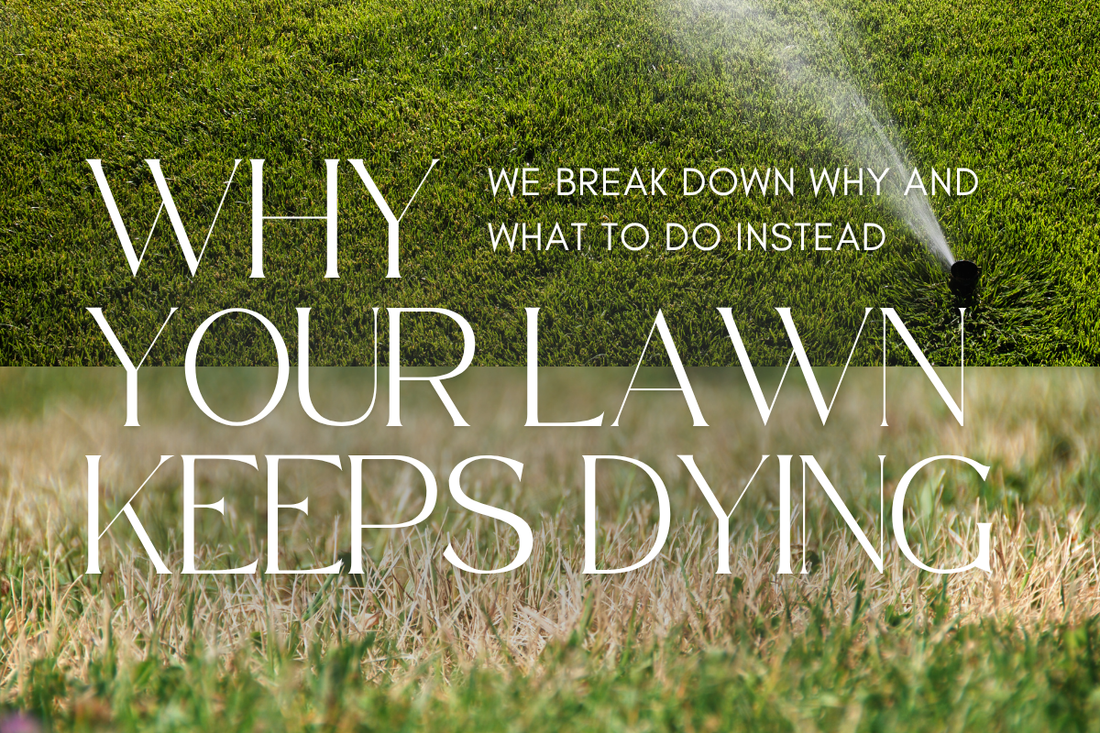Every summer, the same thing happens: your lawn turns brown, dry, patchy—or worse, dies completely. You've watered more, mowed less, maybe even fertilized. But nothing seems to help it thrive in the heat.
Here’s the good news: it’s not your fault. The real problem is the kind of grass you're trying to grow. The truth is, most traditional lawns will fail in hot, dry conditions—and summer just brings those issues to the surface.
In this guide, we’ll break down why your lawn keeps dying every summer and what you can do instead. Spoiler: there are low-maintenance, eco-friendly alternatives that actually want to grow where you live.
Why Traditional Lawns Struggle in the Summer
Most of today’s lawns are made up of cool-season grasses like Kentucky Bluegrass or Ryegrass. These grasses were imported from cooler climates and were never designed for hot, dry summers.
Here’s why they fail:
- Shallow root systems dry out quickly in the heat
- High water needs make them unsustainable during drought
- Frequent mowing and fertilizing stress the grass even more
- They go dormant—or die—under summer conditions
It’s not that your lawn is lazy. It’s just trying to survive in a climate it doesn’t belong in.
The Cost of Keeping It Green
Trying to keep a traditional lawn alive in the summer often comes at a high price, both for you and the environment.
- Soaring water bills as you try to keep up with evaporation and drought
- Regular chemical inputs (fertilizers, herbicides, pesticides)
- Weekly mowing using gas-powered equipment
- Time spent maintaining a lawn that doesn’t give back
And what’s the reward? A lawn that still browns by July.
What to Do Instead: Smarter Lawn Alternatives
Luckily, there are better ways to get a green, healthy lawn that works with nature instead of against it. Native lawn alternatives are lower-maintenance, drought-tolerant, and downright beautiful once established.
Option 1: Replace It with Native or Eco-Friendly Grass Blends
Native grasses like Buffalograss and Blue Grama evolved to thrive in North American climates. They're resilient, low-growing, and naturally adapted to heat and drought.
- Requires far less water after establishment
- No fertilizers or pesticides needed
- Mow optional – keep it natural or trim it for a tidy look
- Soft texture that’s kid- and pet-friendly
Try our FireGuard™ Lawn Blend for drought- and wildfire-prone regions
Or explore the TrueGrass Native Lawn for a classic native look
Option 2: Overseed Bare or Damaged Spots
You don’t have to rip out your entire lawn to make a difference. Overseeding is an easy way to improve struggling areas or start a gradual transition.
You can overseed:
- Bare patches from sun or traffic
- Pet-damaged spots with urine or digging
- The entire lawn to strengthen and diversify it
Overseeding with native grasses helps build a thicker, healthier turf over time—without starting from scratch.
Option 3: Replace Your Lawn in Stages
Not ready to go all in? Try a phased approach:
- Sheet mulch or solarize one section at a time
- Replace with low-growing wildflower or native groundcover seed
- Build native borders, expand beds, or swap your park strip first
This method is budget-friendly and easier to manage, especially if you have HOA rules or a large yard.
How to Make the Switch
Whether you’re starting fresh or overseeding, success starts with the right steps:
-
Pick your regionally appropriate seed mix
(We’ve done the hard work for you—check our curated native blends.) - Prep the area
- Remove existing turf
- Lightly loosen soil
- Water deeply before planting (especially in dry areas)
3. Spread your seed evenly
- Use a broadcast spreader or hand toss
- Rake in gently or topdress with soil
4. Water consistently until established
- Daily light watering for 2–3 weeks
- Once rooted, you can taper off significantly
Get full instructions in our Alternative Lawn Seed Planting Instructions
What to Expect From a Native Lawn
- Year 1 – Establishment. Roots grow deep. Some patchiness is normal.
- Year 2 and beyond – A fuller, denser, and more resilient lawn with minimal effort.
- Maintenance – Occasional mow if desired, spot weed as needed, almost no watering after year one.
No weekly mow. No sprinkler guilt. Just a yard that works with your climate, not against it.
Ready to Stop Fighting Your Lawn?
It’s time to stop pouring water and chemicals into a system that’s working against you and start planting something that actually wants to grow.
Whether you’re overseeding pet spots or transforming your whole yard, we’ve got native seed blends to help you make the switch with confidence.

